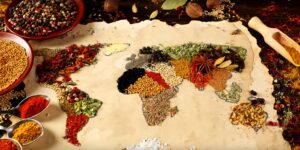
.
Spices have played a vital role in shaping culinary traditions, economies, and even world history. Used across civilizations for thousands of years, they are far more than simple flavor enhancers — they carry deep cultural, medicinal, and spiritual significance.
Historically, the desire for spices such as black pepper, cinnamon, cloves, and nutmeg drove exploration, trade, and even conflict. Entire trade routes, including the famous Silk Road and the Spice Route, were established to transport these precious goods from Asia and the Middle East to Europe and beyond. For many societies, spices symbolized wealth and power, and their value often rivaled that of gold.
Culturally, spices are embedded in identity and tradition. In Indian cuisine, spices like turmeric, cumin, coriander, and cardamom are central to both flavor and health, playing a key role in Ayurvedic medicine. In Middle Eastern cooking, blends like za’atar and baharat reflect centuries of regional influence and heritage. In East Asia, ginger and star anise are not only culinary staples but also revered in traditional Chinese medicine.
Beyond their culinary and cultural uses, spices have long been appreciated for their health benefits. Many contain antioxidants, anti-inflammatory compounds, and antimicrobial properties. For instance, turmeric is known for its anti-inflammatory effects, cinnamon may help regulate blood sugar, and garlic is often praised for its immune-boosting qualities.
In modern kitchens around the world, spices continue to inspire creativity and connection. They allow home cooks and professional chefs alike to bring global flavors into their dishes, honoring tradition while also experimenting with fusion and innovation. Whether used in a comforting stew, a bold curry, or a refreshing herbal tea, spices remain a powerful link to history, healing, and human connection.

